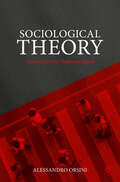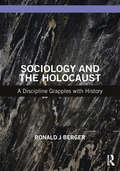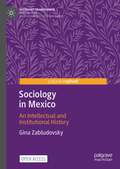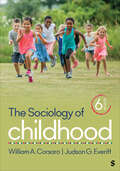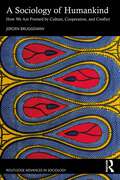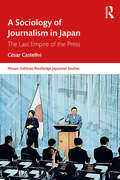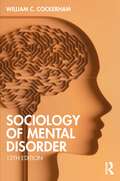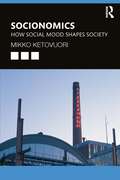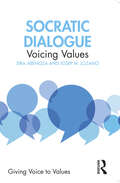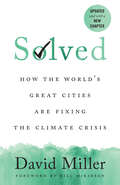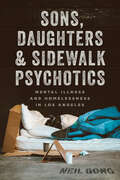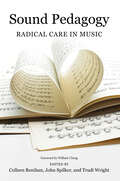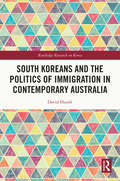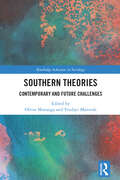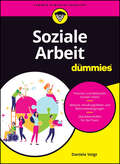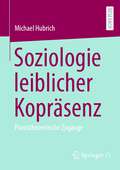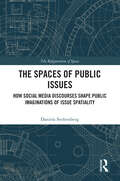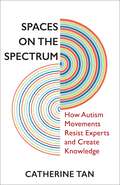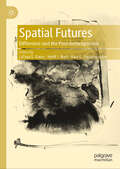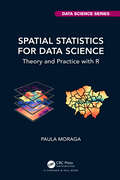- Table View
- List View
Sociological Theory: From Comte to Postcolonialism
by Alessandro OrsiniThis textbook analyses the work of classical and contemporary sociological theorists. The first part is dedicated to Comte, Spencer, Marx, Durkheim, Weber, Pareto, and Simmel. The second part covers the major contemporary sociological perspectives: Functionalism, Marxism, Conflict Theory, Symbolic Interactionism, Phenomenological Sociology, and Rational Choice Theory. The third part is devoted to Postmodern Theory, Feminist Theory, Postcolonial Theory, and Race Theory. The author combines academic rigour with clear and accessible language, offering students an in-depth and extensive overview of the main, recurring problems that have troubled sociological theory from its origins to the present day. The textbook uses contemporary examples, analysing how sociological theory can explain the most tragic phenomena of our time, including the war in Ukraine, the Israeli-Palestinian conflict, US-China competition over Taiwan, nuclear proliferation, radicalization, neofascism, white suprematism, jihadism, and terrorism. With pedagogic features aiding learning, this book helps navigate the various approaches, methods, and research that divide sociologists into distinct schools. This textbook is therefore an invaluable tool to any sociology student looking to gain a comprehensive understanding of the foundational thinkers that have shaped the discipline.
Sociology and the Holocaust: A Discipline Grapples with History
by Ronald J BergerFor some time the conventional wisdom in the interdisciplinary field of Holocaust studies is that sociologists have neglected this subject matter, but this is not really the case. In fact, there has been substantial sociological work on the Holocaust, although this scholarship has often been ignored or neglected including in the discipline of sociology itself. Sociology and the Holocaust brings this scholarly tradition to light, and in doing so offers a comprehensive synthesis of the vast historical and social science literature on the before, during, and after of the Holocaust—a tour d’horizon from an explicitly sociological perspective. As such, the aim of the book is not simply to describe the chronology of events that culminated in the deaths of 6 million Jews but to draw upon sociology’s “theoretical toolkit” to understand these events and the ongoing legacy of the Holocaust sociologically.
Sociology and the Holocaust: A Discipline Grapples with History
by Ronald J BergerFor some time the conventional wisdom in the interdisciplinary field of Holocaust studies is that sociologists have neglected this subject matter, but this is not really the case. In fact, there has been substantial sociological work on the Holocaust, although this scholarship has often been ignored or neglected including in the discipline of sociology itself. Sociology and the Holocaust brings this scholarly tradition to light, and in doing so offers a comprehensive synthesis of the vast historical and social science literature on the before, during, and after of the Holocaust—a tour d’horizon from an explicitly sociological perspective. As such, the aim of the book is not simply to describe the chronology of events that culminated in the deaths of 6 million Jews but to draw upon sociology’s “theoretical toolkit” to understand these events and the ongoing legacy of the Holocaust sociologically.
Sociology in Mexico: An Intellectual and Institutional History (Sociology Transformed)
by Gina ZabludovskyThis open access book presents a condensed history of Sociology in Mexico from its origins, through to the middle of the 19th century and up to the present day. The book analyses the interaction between sociology and the main economic, political and social change in the country, including the 1910 Mexican Revolution, the main social movements, the role of the intellectual exiles from Spain and Latin America, and the participation of women, who have often remained invisible in the history of sociology. The book explores how sociological discourse played a fundamental role in the separation of secular and public education and the search for a ‘national project’ from 1868 onwards, despite the lack of an institute of social research until 1930; how sociology became an autonomous social science, led by a few intellectuals and public figures, as it became institutionalized in universities, and the effect this had on the development of the discipline; the influence of Marxism during the 1970s; and the progression from a process of specialization after the fall of the Berlin Wall to a new trend of working in collective projects with an increasing interdisciplinary perspective in the first decades of the 21st century.
The Sociology of Childhood (Sociology for a New Century Series)
by William A. Corsaro Judson G. EverittThe Sixth Edition of William A. Corsaro and Judson G. Everitt′s groundbreaking text discusses children and childhood from a sociological perspective—providing in-depth coverage of social theories of childhood, the peer cultures and social issues of children and youth, and children and childhood within the frameworks of culture and history. This revised edition has been thoroughly updated to incorporate the latest research and the most pertinent information so readers can engage in powerful discussions on a wide array of topics.
The Sociology of Childhood (Sociology for a New Century Series)
by William A. Corsaro Judson G. EverittThe Sixth Edition of William A. Corsaro and Judson G. Everitt′s groundbreaking text discusses children and childhood from a sociological perspective—providing in-depth coverage of social theories of childhood, the peer cultures and social issues of children and youth, and children and childhood within the frameworks of culture and history. This revised edition has been thoroughly updated to incorporate the latest research and the most pertinent information so readers can engage in powerful discussions on a wide array of topics.
A Sociology of Humankind: How We Are Formed by Culture, Cooperation, and Conflict (Routledge Advances in Sociology)
by Jeroen BruggemanBased upon the interdependencies of human beings as we cooperate and conflict with each other, how we share information, and how culture evolves, this book proposes a sociology of humanity covering three hundred millennia. Grounded in empirical findings from archaeology, history, lab experiments, and field studies – supplemented for precision with computational network models of cultural evolution, cooperation, influence, cohesion, warfare, power, social balance, and inequality – this is the first attempt at encompassing sociology of humankind. Informed by the theory of cultural evolution, it extends the notion that cultural evolution connects humans of all times in a giant sociocultural network, thereby yielding coherence between a great many empirical findings. It will therefore appeal to scholars of sociology and anthropology with interests in historical sociology, cultural evolution, and social theory.
A Sociology of Journalism in Japan: The Last Empire of the Press (ISSN)
by César CastellviThis book represents an in-depth analysis of journalism in Japan during the golden era of the daily press and the gradual introduction of digital technology starting from the mid-1980s to the late 2010s.By presenting firsthand testimony from journalists and field notes collected from fieldwork in the newsroom of one of the country's largest newspapers, this book provides a unique insight into Japan’s highly active yet relatively under-institutionalized journalistic profession. It also explores the changes experienced by the organizational development of Japanese journalism in response to broader changes in Japanese society, such as the emergence of social networks, the evolution of reading practices, the demographic situation, and the new aspirations of the Japanese youth.Based on an extensive ethnographic fieldwork carried out by the author over several years, this book will be of huge interest to students and scholars of Japanese society, journalism, and media studies.
Sociology of Mental Disorder
by William C. CockerhamThe twelfth edition of the Sociology of Mental Disorder presents the major issues and research findings on the influence of race, social class, gender, and age on the incidence and prevalence of mental disorders. The text also examines the institutions that help those with mental disorders, mental health law, and public policy. Many important updates are new to this edition: The mental health effects of the COVID-19 pandemic are examined. Aging and mental health is discussed in more detail. Updated review of gender differences in mental disorder. A revised and more in-depth discussion of mental health and race. Problems in the community care of the mentally ill are covered. Updates of research and citations throughout. Blending foundational concepts and sociological perspectives on mental health issues with newer studies and accounts in an accessible and authoritative survey of the field, the new edition of Sociology of Mental Disorder remains an essential text and an invaluable resource for students and scholars.
Socionomics: How Social Mood Shapes Society
by Mikko KetovuoriSocionomics: How Social Mood Shapes Society explores the main principles and applications of socionomic theory as elaborated by Robert Prechter. Socionomic theory posits that an omnipresent social mood, shifting constantly in a wave form through all aspects of society, is responsible for the aggregate tenor and character of all social, economic and cultural trends, from fluctuations in the stock market to the popularity of particular genres of music at a given time.The social mood as an endogenous and collective force has its roots in the herding instinct often identified amongst crowds. Individuals typically make rational decisions when acting alone, and in the context of certainty, but in groups and in context of uncertainty, mood-based mimetic behavior can affect all the participants. As social mood often goes unnoticed, people tend to give their collective feelings labels to rationalize them, thus constituting ‘public opinion’. Therefore, whilst ‘public opinion’ as presented in the media is usually seen as rational, it is in fact based on the social mood context that often determines how people think, feel and behave. As the internet and social media have become ubiquitous in our daily lives, these rationalizations are spreading faster and faster than ever before and creating a pseudo-reality which can corrupt the collective perception of what is real and what is not.This stimulating and thought-provoking book will be of great interest to academics, practitioners and policymakers with an interest in the humanities and social sciences, particularly sociology and economics.
Socratic Dialogue: Voicing Values (Giving Voice to Values)
by Sira Abenoza Josep M. LozanoGiving Voice to Values is a very important tool that has helped many professionals better align what they do with what they value and believe. This book introduces the methodology of Socratic Dialogue as a complementary set of tools for creating spaces of joint reflection in which one can gain clarity about one’s values and gain the confidence to voice them effectively. Socrates’ main concern was to progressively reach a higher alignment between ideas and actions: that is, to achieve a harmony between what we think, what we say and what we do. The first step to giving voice to our values involves introspection and dialogue with others – which is how we can become aware of what we really think and value. An examined life, Socrates reminds us, is a fulfilled one. Based on the authors' more than ten years’ experience teaching Socratic Dialogue to business and law students, executives and professionals, faculty, incarcerated people and other vulnerable groups, the book provides teachers and practitioners with a roadmap to conceive, design and conduct Socratic Dialogue courses and sessions. It provides context for the method and its adaptation to the challenges of the 21st century. The book also offers guidance on how to structure a Socratic Dialogue classroom, as well as a series of tried-and-true activities and exercises, practical recommendations and testimonies of the transformative impact that dialogue courses have had on participants. The book is of prime interest to professors and educators of business ethics, as well as professional consultants working to help organizations become more responsible and introduce ethical reasoning in their decisions. It also serves as a valuable resource for social educators and practitioners in prisons and rehabilitation units, as well as teachers in primary and secondary education.
Solved: How the World’s Great Cities Are Fixing the Climate Crisis
by David MillerIf our planet is going to survive the climate crisis, we need to act rapidly. Taking cues from progressive cities around the world, including Los Angeles, New York, Toronto, Oslo, Shenzhen, and Sydney, this book is a summons to every city to make small but significant changes that can drastically reduce our carbon footprint. We cannot wait for national governments to agree on how to reduce greenhouse gas emissions and manage the average temperature rise to within 1.5 degrees. In Solved, David Miller argues that cities are taking action on climate change because they can – and because they must. The updated paperback edition of Solved: How the World’s Great Cities Are Fixing the Climate Crisis demonstrates that the initiatives cities have taken to control the climate crisis can make a real difference in reducing global emissions if implemented worldwide. By chronicling the stories of how cities have taken action to meet and exceed emissions targets laid out in the Paris Agreement, Miller empowers readers to fix the climate crisis. As much a “how to” guide for policymakers as a work for concerned citizens, Solved aims to inspire hope through its clear and factual analysis of what can be done – now, today – to mitigate our harmful emissions and pave the way to a 1.5-degree world.
Sons, Daughters, and Sidewalk Psychotics: Mental Illness and Homelessness in Los Angeles
by Neil GongSociologist Neil Gong explains why mental health treatment in Los Angeles rarely succeeds, for the rich, the poor, and everyone in between. In 2022, Los Angeles became the US county with the largest population of unhoused people, drawing a stark contrast with the wealth on display in its opulent neighborhoods. In Sons, Daughters, and Sidewalk Psychotics, sociologist Neil Gong traces the divide between the haves and have-nots in the psychiatric treatment systems that shape the life trajectories of people living with serious mental illness. In the decades since the United States closed its mental hospitals in favor of non-institutional treatment, two drastically different forms of community psychiatric services have developed: public safety-net clinics focused on keeping patients housed and out of jail, and elite private care trying to push clients toward respectable futures. In Downtown Los Angeles, many people in psychiatric crisis only receive help after experiencing homelessness or arrests. Public providers engage in guerrilla social work to secure them housing and safety, but these programs are rarely able to deliver true rehabilitation for psychological distress and addiction. Patients are free to refuse treatment or use illegal drugs—so long as they do so away from public view. Across town in West LA or Malibu, wealthy people diagnosed with serious mental illness attend luxurious treatment centers. Programs may offer yoga and organic meals alongside personalized therapeutic treatments, but patients can feel trapped, as their families pay exorbitantly to surveil and “fix” them. Meanwhile, middle-class families—stymied by private insurers, unable to afford elite providers, and yet not poor enough to qualify for social services—struggle to find care at all. Gong’s findings raise uncomfortable questions about urban policy, family dynamics, and what it means to respect individual freedom. His comparative approach reminds us that every “sidewalk psychotic” is also a beloved relative and that the kinds of policies we support likely depend on whether we see those with mental illness as a public social problem or as somebody’s kin. At a time when many voters merely want streets cleared of “problem people,” Gong’s book helps us imagine a fundamentally different psychiatric system—one that will meet the needs of patients, families, and society at large.
Sound Pedagogy: Radical Care in Music (Music in American Life)
by Molly M Breckling William Everett Kate Galloway Sara Haefeli Eric Hung Stephanie Jensen-Moulton Mark Katz Nathan A Langfitt Matteo Magarotto Mary Natvig Frederick A Peterbark Laura Moore Pruett Colleen Renihan Amanda Christina Soto John Spilker Reba A Wissner Trudi WrightMusic education today requires an approach rooted in care and kindness that coexists alongside the dismantling of systems that fail to serve our communities in higher education. But, as the essayists in Sound Pedagogy show, the structural aspects of music study in higher education present obstacles to caring and kindness like the entrenched master-student model, a neoliberal individualist and competitive mindset, and classical music’s white patriarchal roots. The editors of this volume curate essays that use a broad definition of care pedagogy, one informed by interdisciplinary scholarship and aimed at providing practical strategies for bringing transformative learning and engaged pedagogies to music classrooms. The contributors draw from personal experience to address issues including radical kindness through universal design; listening to non-human musicality; public musicology as a forum for social justice discourse; and radical approaches to teaching about race through music. Contributors: Molly M. Breckling, William A. Everett, Kate Galloway, Sara Haefeli, Eric Hung, Stephanie Jensen-Moulton, Mark Katz, Nathan A. Langfitt, Matteo Magarotto, Mary Natvig, Frederick A. Peterbark, Laura Moore Pruett, Colleen Renihan, Amanda Christina Soto, John Spilker, Reba A. Wissner, and Trudi Wright
South Koreans and the Politics of Immigration in Contemporary Australia (Routledge Research on Korea)
by David HundtThe book explores the politics of immigration in Australia through an in-depth study of the ‘new generation’ of young Korean migrants in Melbourne. States with high rates of immigration such as Australia can largely determine who enter their societies, but some migrants, such as younger Koreans, can determine how and where they live due to desirable attributes such as their skills, education, and adaptability. The book uses Albert Hirschman’s ‘exit, voice, and loyalty’ schema to explore the choices available to such new and would-be citizens, especially when faced with economic, social, and/or political decline in their host society. Through in-depth interviews, the book explores if young Koreans were most attracted to the options of staying in Australia (loyalty), changing it from within (voice), or leaving (exit). The most common experience among younger Koreans, the book finds, is loyalty: most respondents express satisfaction with their lives in Australia and want to make it their home. These findings reveal how a particular group of migrants negotiates their citizenship with a would-be host society. By extension, the book illustrates the range and degree of strategies available to other migrants and would-be migrants, and how they might secure their livelihoods and well-being at a time of greater restrictions on international migration. This book will be of interest to scholars of multiculturalism and immigration history in Australia, citizenship and migration, and Korean studies.
Southern Theories: Contemporary and Future Challenges (Routledge Advances in Sociology)
by Oliver Mutanga Tendayi MarovahThis book critically explores Global South perspectives, examining marginalised voices and issues whilst challenging the supremacy of Global North perspectives in literature. The unique value of this book lies in its extensive coverage of various Southern challenges, including disaster management, climate change, communication, resilience, gender, education, and disability. It also underscores the relevance of indigenous philosophies such as animism, Buen Vivir, Buddhism, Confucianism, Daoism, Neozapatism, Qi vitality, Taoism, and Ubuntu. Stemming from regions as diverse as Sub-Saharan Africa, Asia, and Latin America, these philosophies are brought into public discourse. By demonstrating their practicality in designing intervention programs and influencing policy-making, the book fills a critical gap in global Southern literature while promoting context-specific knowledge for improving well-being in the Global South contexts. This book’s content resonates with a diverse audience, encompassing students, academics, researchers, NGOs, and policymakers from postcolonial states in the Global South and those from Global North countries. Furthermore, it is highly relevant to communities within the Global North that mirror the Global South – those grappling with equity issues for indigenous populations. It has a versatile appeal that transcends disciplinary boundaries, encompassing cultural studies, sociology, international development, philosophy, and postcolonial studies, thus making it accessible to all educational levels. It holds particular interest for those in development studies, indigenous studies, government departments globally, international organisations, and universities worldwide.
Soziale Arbeit für Dummies (Für Dummies)
by Daniela VoigtSozial — Alles, was Sozialarbeiter schon immer wissen wollten Ein Buch für Studierende und Sozialarbeiter, das einen wunderbaren Überblick über das Thema gibt und dabei Theorie und Praxis verbindet. Sie lernen Hand-lungsfelder, Akteure und Rahmenbedingungen der Sozialen Arbeit kennen und gewinnen ein Grundverständnis von Methoden und Theorien. Zugleich erhalten Sie für Ihren Arbeitsalltag als Sozialarbeiter Survival Hacks und Überlebenstipps. Daniela Voigt erklärt verständlich und anhand vieler anschaulicher Beispiele, was Soziale Arbeit ausmacht und wie sie dazu beitragen kann, Menschen zu unterstützen, gesellschaftliche Probleme zu lösen und die Welt ein wenig sozialer und gerechter zu machen. Sie erfahren Was die Arbeit mit Menschen so speziell macht Welche Methoden Ihnen helfen, Hilfe zur Selbsthilfe zu geben Was den idealtypischen Sozialarbeiter ausmacht Wissenswertes über die Entstehung der Sozialen Arbeit
Soziale Netzwerkbeziehungen in Coworking Spaces: Eine Untersuchung zur organisationalen Einbettung von Freelancer*innen
by Michael T. KnappDie Studie von Michael Knapp befasst sich mit den sozialen Netzwerkbeziehungen von Freelancer*innen im Kontext von Coworking Spaces als flexibel nutzbare Büro- und Arbeitsräumlichkeiten. Dabei wird insbesondere auf die Bedeutung dieses Kontexts in Bezug auf die Beziehungs- und Netzwerkbildung eingegangen und gezeigt, wie die Nutzung eines Arbeitsplatzes in diesem zur organisationalen Einbettung im Freelancing beitragen kann. Dazu greift die Arbeit auf Methoden der egozentrierten Netzwerkanalyse in Kombination mit qualitativen Interviews zurück. Anhand von persönlichen Freelancer*innen-Netzwerken, biografischen und sozial-räumlichen Hintergründen werden verschiedene Beziehungsinhalte und -konstellationen deutlich gemacht, die sich aus der Arbeit im Coworking Space ergeben können. Die Studie trägt damit zum Verständnis von Coworking Spaces für unternehmerische Prozesse im Freelancing bei und verweist auf die Relevanz von sozial-räumlicher Kontextualisierung.
Sozialisationsprozesse von männlichen Nachwuchsleistungssportlern in Sportinternaten: Eine (auto-)biographisch-narrative Forschung (Erziehungswissenschaftliche Edition: Persönlichkeitsbildung in Schule)
by Julia PerlingerDie vorliegende Studie befasst sich mit differenten Sozialisationsprozessen von männlichen Nachwuchsleistungssportlern aus dem Sektor Handball, welche in (Sport-)Internaten leben. Um der Forschungsfrage ‚Wie gestalten sich Sozialisationsprozesse von männlichen Nachwuchsleistungssportlern in Leistungssportinstitutionen mit Internat?‘ nachgehen zu können, wurden in drei verschiedenen Internatseinrichtungen mit leistungssportlichem Profil biographisch-narrative Interviews durchgeführt. Die empirische Arbeit wird der qualitativen Sozialforschung zugeordnet. Die Zielgruppe der Biographieforschung setzt sich aus Nachwuchsleistungssportlern im Alter von 15 bis 20 Jahren zusammen, um die subjektive Sichtweise und Erfahrungswerte aus Perspektive der Nachwuchsleistungssportler transparent machen zu können. Die erhobenen Daten wurden im Anschluss anhand der Narrationsanalyse nach Schütze ausgewertet.
Soziologie leiblicher Kopräsenz: Praxistheoretische Zugänge
by Michael HubrichDas Buch stellt die sozialtheoretische Frage nach der besonderen Qualität leiblicher Kopräsenz, verstanden als Urszene des Sozialen, und beantwortet sie mit den Mitteln einer leibphänomenologisch instruierten Praxistheorie. Ausgehend von einer Kritik am Cartesianismus klassischer Intersubjektivitäts-, Interaktions- und Kommunikationstheorien wird ein sich gegen tradierte epistemologische Dualismen richtendes und relational formuliertes Vokabular entwickelt, welches sich maßgeblich an den Begriffen der Praxis und des Leibes orientiert. Dadurch ist es möglich, die Sozialität in gemeinsamer Anwesenheit als ein sich in Wahrnehmung und Bewegung entfaltendes und dadurch affektives wie habituelles Praxisgeschehen zu erfassen. Im Zentrum des Buches stehen damit praxistheoretische Zugänge für eine Soziologie leiblicher Kopräsenz, mit denen (über-)situative Qualitäten der Mit-Anwesenheit soziologisch sicht- und analysierbar werden.
The Spaces of Public Issues: How Social Media Discourses Shape Public Imaginations of Issue Spatiality (The Refiguration of Space)
by Daniela StoltenbergIdeas about matters of public concern are shaped by the spaces associated with them: Events occur in particular places, political regulations apply to specific territories, people in different locations are differentially affected by issues. Yet, political communication research has neglected the question of how the spaces of public issues are constructed in the public sphere. This is especially true for research on social media communication, which is often perceived as placeless. Yet, social media discourses are driven by unequal attention patterns based on users’ interests, resources, and abilities. To understand how these patterns manifest spatially, this interdisciplinary monograph builds on public spheres theory, communication infrastructure theory, and urban sociology to develop the framework of issue spatiality. It focuses on how social media users discuss different places in urban policy issue discourses. By applying the framework to four large-scale Twitter discourses on housing markets and cycling infrastructure in two German cities, Berlin and Frankfurt, the research reveals the spatial patterns and inequalities of social media discourses. It demonstrates that digital discourses are overwhelmingly focused on a small number of places in the urban center. These places emerge as the locus of activism and political controversy, while the urban periphery remains hidden or is discussed in purely administrative terms. Places with dense civic infrastructure and privileged residents receive disproportionate attention. The book provides an in-depth look at the ways in which socio-spatial inequalities are inscribed in public communication and shape ideas about societal issues.
Spaces on the Spectrum: How Autism Movements Resist Experts and Create Knowledge
by Catherine TanMovements that take issue with conventional understandings of autism spectrum disorder, a developmental disability, have become increasingly visible. Drawing on more than three years of ethnographic fieldwork and interviews with participants, Catherine Tan investigates two autism-focused movements, shedding new light on how members contest expert authority. Examining their separate struggles to gain legitimacy and represent autistic people, she develops a new account of the importance of social movements as spaces for constructing knowledge that aims to challenge dominant frameworks.Spaces on the Spectrum examines the autistic rights and alternative biomedical movements, which reimagine autism in different and conflicting ways: as a difference to be accepted or as a sickness to treat. Both, however, provide a window into how ideas that conflict with dominant beliefs develop, take hold, and persist. The autistic rights movement is composed primarily of autistic adults who contend that autism is a natural human variation, not a disorder, and advocate for social and cultural inclusion and policy changes. The alternative biomedical movement, in contrast, is dominated by parents and practitioners who believe in the disproven idea that vaccines trigger autism and seek to reverse it with scientifically unsupported treatments. Both movements position themselves in opposition to researchers, professionals, and parents outside their communities. Spaces on the Spectrum offers timely insights into the roles of shared identity and communal networks in movements that question scientific and medical authority.
Spatial Futures: Difference and the Post-Anthropocene
by LaToya E. Eaves Heidi J. Nast Alex G. PapadopoulosSpatial Futures invites readers to imagine power and freedom through the lens of the ‘Black Outdoors’, a transdisciplinary spatial concept that operates beyond the planetary, stratigraphic confines of the ‘Anthropocene’. The chapters collectively point to the ontological-epistemological contradictions involved in forging liberatory spatial futures. Bringing new spatial imaginaries to bear in and outside geography, the book refuses the strictures of the ‘cenic’, entertaining difference as world-making.
Spatial Statistics for Data Science: Theory and Practice with R (Chapman & Hall/CRC Data Science Series)
by Paula MoragaSpatial data is crucial to improve decision-making in a wide range of fields including environment, health, ecology, urban planning, economy, and society. Spatial Statistics for Data Science: Theory and Practice with R describes statistical methods, modeling approaches, and visualization techniques to analyze spatial data using R. The book provides a comprehensive overview of the varying types of spatial data, and detailed explanations of the theoretical concepts of spatial statistics, alongside fully reproducible examples which demonstrate how to simulate, describe, and analyze spatial data in various applications. Combining theory and practice, the book includes real-world data science examples such as disease risk mapping, air pollution prediction, species distribution modeling, crime mapping, and real state analyses. The book utilizes publicly available data and offers clear explanations of the R code for importing, manipulating, analyzing, and visualizing data, as well as the interpretation of the results. This ensures contents are easily accessible and fully reproducible for students, researchers, and practitioners. Key Features: Describes R packages for retrieval, manipulation, and visualization of spatial data Offers a comprehensive overview of spatial statistical methods including spatial autocorrelation, clustering, spatial interpolation, model-based geostatistics, and spatial point processes Provides detailed explanations on how to fit and interpret Bayesian spatial models using the integrated nested Laplace approximation (INLA) and stochastic partial differential equation (SPDE) approaches
Sport in der totalen Institution – eine Gefängnisethnographie (Sport – Gesellschaft – Kultur)
by Johannes MüllerJustizvollzugsanstalten müssen Gefangenen die Möglichkeit anbieten, sich sportlich zu betätigen. Basierend auf mehrjähriger ethnographischer Forschung in einem Gefängnis untersucht das Buch die vielschichtigen Bedeutungen, die der Sport aus Sicht der Gefangenen besitzt. Die Befunde zeigen, dass sich Sport für einen Teil der männlichen Insassen als Bewältigungsstrategie zur Linderung der hafttypischen Belastungen erweist, indem er Freiheitsmomente birgt und Möglichkeiten eröffnet, gefängnistypischen Gefühlen von Angst, Einsamkeit, Langeweile und mentaler Niedergeschlagenheit zu begegnen. Darüber hinaus stellt der Sport ein probates Mittel zur Konstruktion bzw. Verteidigung von Männlichkeit, zur Selbstaufwertung und zur Positionierung in der sozialen Hierarchie unter den Gefangenen dar. Die Befunde zeigen weiterhin, dass speziell die Teilhabe an anstaltsorganisierten Sportangeboten voraussetzungsvoll ist und das besondere Gefängnissetting viele Inhaftierte von einer Sportteilhabe abhält.
